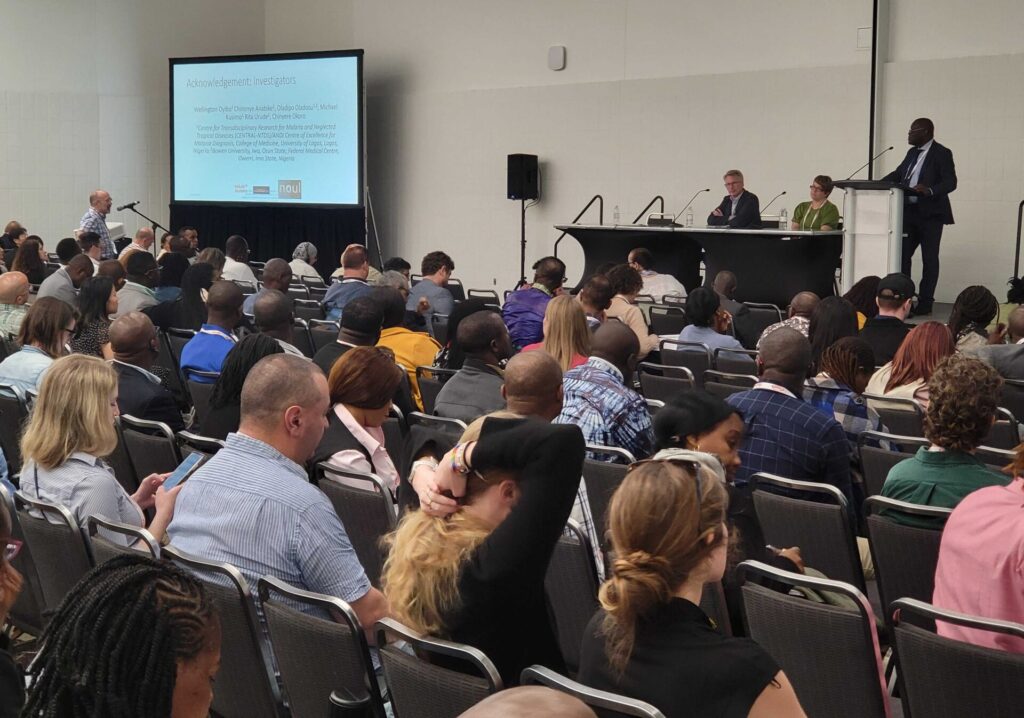The American Society of Tropical Medicine and Hygiene (ASTMH) hosted a conference in 2024 to exchange ideas and clinical advances related to tropical medicine, hygiene, and global health. It was a chance for leading companies to showcase their latest technologies.
NOUL, a leading global health diagnostics company, attended ASTMH 2024 conference, showcasing their groundbreaking diagnostic platform, miLab™ MAL. The impressive system already has a 94.4% sensitivity and 98.1% specificity rate, outperforming traditional microscopy. It’s a landmark step in digital microscopy.
Plasmodium Falciparum and the Global Health Impact of Malaria
Plasmodium falciparum, though not a common name outside of medical circles, is one of the deadliest organisms in human history. It’s the parasite responsible for malaria. Endemic to sub-Saharan Africa, it poses a significant disease burden for the resource-limited region.
The parasite accounts for around 90% of all malaria cases worldwide. Given that there were 249 million cases of malaria globally in 2022, Plasmodium falciparum was involved in approximately 224.1 million. It remains one of the leading causes of malaria-related deaths globally.
Part of the problem is the difficulty in diagnosing the condition. Due to a lack of resources, patients must travel to the nearest clinic, which can be several miles away. Even when they arrive, they can face long waiting times, during which time the parasite multiplies and the condition intensifies. With malaria, every second counts.
miLab™ MAL offers a promising and effective solution. Its rapid and reliable diagnosis is perfect for rural or low-resource settings where access to malaria testing isn’t usually available. The earlier the condition can be diagnosed, the lower the morbidity and mortality rate.
Innovations in Digital Microscopy and miLab™ at ASTMH 2024
 Source : NOUL
Source : NOUL
At ASTMH 2024, NOUL showcased the miLab™ MAL. But what is it? And how does it work?
The diagnostic platform is an AI-enhanced automated digital microscope, designed specifically for rapid and accurate malaria diagnosis. Digital microscopy is an emerging trend in modern diagnostics, especially in resource-limited settings. Where the miLab™ MAL differs is the use of AI. It combines advanced image processing and automation to detect the presence of Plasmodium falciparum in a blood sample.
NOUL gave one oral presentation and two poster presentations at ASTMH 2024:
Oral Presentation:
- Date: November 14, 2024
- Title: “Analytical Performance Assessment of the Automated and Artificial Intelligence-Enabled miLab™ MAL Malaria system for the Detection of Plasmodium falciparum in Suspected Malaria Patients in Lagos, Nigeria”
- Presenter: Prof. Wellington Oyibo, College of Medicine, University of Lagos
- Key Focus: A comprehensive evaluation of miLab™ MAL for accurate detection of Plasmodium falciparum in clinical settings.
Poster Presentation 1:
- Date: November 15, 2024
- Title: “An Effective Cascading Classifier for Patient-Level Malaria Diagnosis on the miLab™ Platform with Focus-Stacking Tiny Vision Transformer”
- Key Focus: Advancing malaria diagnostics through the integration of machine learning and AI-driven algorithms, leveraging cascading classifiers, Vision Transformers, and z-stacking techniques to enhance accuracy and efficiency.
Poster Presentation 2:
- Date: November 15, 2024
- Title: “Diagnosis of Plasmodium Infections Using Artificial Intelligence Techniques versus Standard Microscopy in a Reference Laboratory”
- Key Focus: Enhanced malaria detection sensitivity with miLab™ MAL in a Labcorp® setting, emphasizing potential as a screening tool and need for refinement in parasitemia accuracy and species validation.
Global Health Challenges and the Role of Innovative Diagnostics
 Source : NOUL
Source : NOUL
ASTMH 2024 wasn’t about any particular region. It was about highlighting the global health issues that define the early 21st century. From tropical diseases and malaria to antibiotic resistance and pandemic preparedness, it’s a chance to talk with experts from around the world who are fighting and raising awareness about each of these issues.
NOUL was proud to join the conversation. We believe the miLab™ MAL is a landmark step towards a new kind of diagnostics. Integrating AI-driven systems with digital microscopy removes the need for high-level experts and costly laboratory equipment.
Nor does it diminish the accuracy of malaria detection. During the conference, we presented the results from a study conducted in Lagos, Nigeria, involving 400 malaria-suspected patients. We measured an impressive 94.4% sensitivity and 98.1% specificity, outperforming traditional microscopy in accuracy.
But we know this is only the beginning – we were excited to hear the questions, thoughts, and insights from attendees who we hope will see the technology’s current value and potential. With demonstrated results in clinical settings, we believe this is a scalable and affordable solution for resource-limited settings.
NOUL’s Commitment to Global Health and Product Overview
 Source : NOUL
Source : NOUL
NOUL remains committed to global health issues. Malaria is an international concern, spanning sub-Saharan Africa, South America, South Asia, and Indonesia. Each of these regions faces different challenges, but malaria is an underlying issue. Many countries within this region are resource-poor, often with villages and towns that remain cut off from modern medicine. Treating individuals in this region requires a new approach to diagnostics.
Our hope is that the miLab™ MAL will open up malaria diagnosis to millions of people. It was designed specifically to tackle issues in isolated or resource-poor countries, using AI and digital microscopy to minimize the need for expertise. Its automated detection of Plasmodium falciparum simplifies and accelerates the diagnostic process, enabling faster treatment.
The benefits are clear:
- Affordable. The platform cuts the cost of expensive diagnostic facilities. Thanks to this single device, people can receive the care they need at a fraction of the price.
- Easy to use. The device doesn’t require lengthy training to use. Anybody can learn to perform the testing with minimal training.
- Adaptable. It works across a diverse landscape of countries, from small villages to towns and cities. It helps close the diagnostic gap, regardless of the setting.
Final Thoughts
 Source : ASTMH
Source : ASTMH
miLab™ MAL has demonstrated transformative potential in revolutionizing malaria diagnosis. It’s a clear demonstration of the power of AI and automation in improving malaria diagnosis in resource-limited settings. We were pleased to engage with experts and peers at ASTMH 2024.
If you missed the presentation or wish to learn more, visit our website or contact us directly for more information. Learn how miLab™ MAL can help improve malaria diagnostics in your region.

